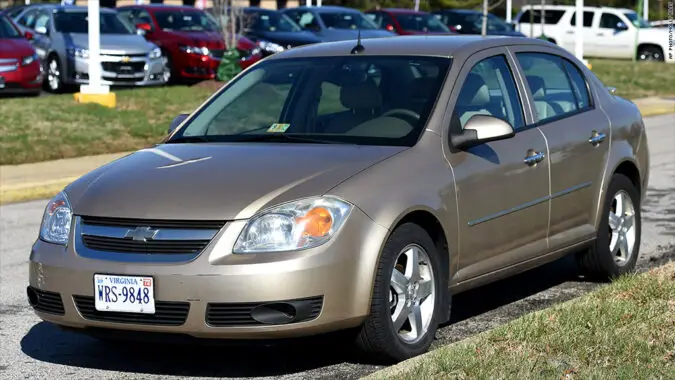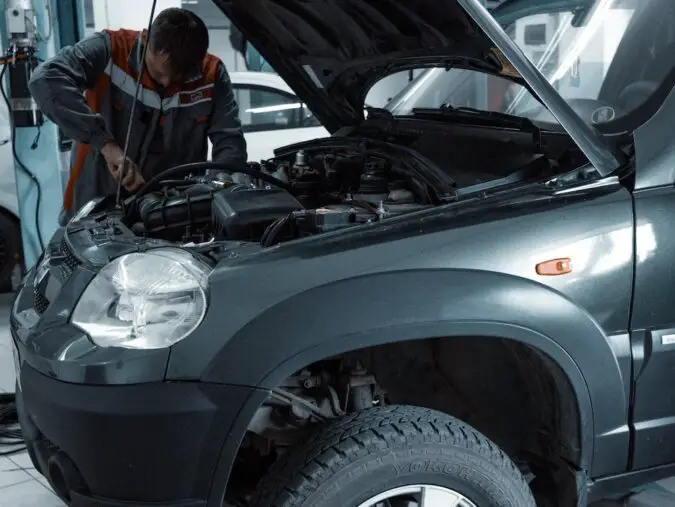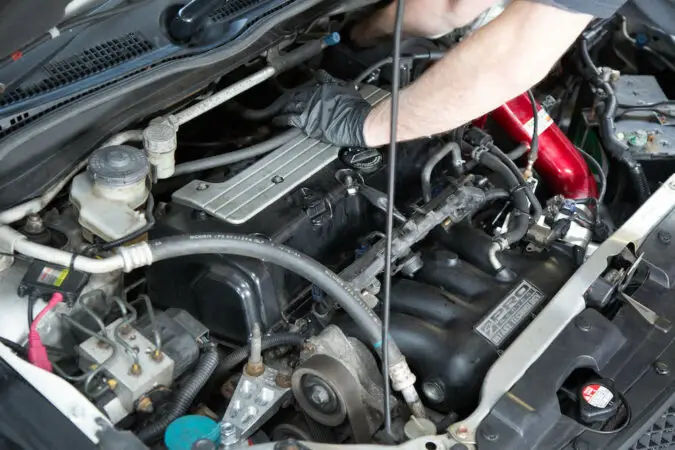Do you have a P0128 trouble code in your Chevy? This trouble code indicates an issue with your Chevy’s cooling system. Most likely with the thermostat. Learn everything you need to know about it in this article, from the cause, repairs, costs, and more.
Here’s our table of contents to help you find the information you need:
P0128 Chevy: What Does It Mean?
The P0128 trouble code in Chevy translates to “Coolant Thermostat Temperature Below Regulating Temperature.” Great, but what does this OBD gibberish mean?
Your Chevy’s cooling system has sensors that measure the engine coolant’s temperature. The temperature sensors serve many purposes. One of which is so that the Engine Control Unit (ECU) knows how much fuel and air to inject into the engine depending on the engine’s temperature.
Anyway, this code means that the coolant is taking too long to reach operating temperature, usually between 195º F and 220º F. In the case of Chevy cars, it usually has to reach at least 160º F in 15 minutes. If the car fails to reach this temperature or takes too long, it will register this trouble code and trigger the check engine light.
We should mention that this is a generic OBD-2 trouble code. So, this code means the same regardless of make and model. Whether you have a Chevy, Ford, Toyota, or any other car make, this code means the same thing as long as the car has an OBD-2 system, which is virtually every car since 1996.
If you happen to come across this code in a different car make in the future, now you know that it means the same thing. And pretty much everything we discuss here applies to other car makes as well.
The way to tell whether it’s a generic/universal or a manufacturer-specific code is by taking a look at the second digit (the first number after the letter). If it’s a ‘0’ such as in this case, then it’s a generic code. If it’s anything other than ‘0’ then it’s a manufacturer-specific code and may mean different things across manufacturers.
How Your Car’s Cooling System Works
Before we get into more detail, learning how your car’s cooling system works will give you a clearer idea of how this trouble code occurs. If you already know, then you can skip this part. Here are the components that make up the cooling system:
- Radiator.
- Coolant reservoir or expansion tank.
- Coolant and coolant pump.
- Lines and hoses.
- Thermostat.
- Coolant temperature sensor.
When you first start the car, the coolant pump will pump coolant through the engine. During this stage, the thermostat will close its main valve. This forces the coolant from the engine to flow through a bypass valve, which recirculates the coolant immediately back into the engine.
This is so that coolant gets to operating temperature faster on a cold start. Once the coolant gets to a higher temperature—usually around 160º F—the thermostat will close the bypass valve and open the main valve. This allows coolant to circulate to the radiator.
The radiator disperses the heat from the coolant, usually with the help of a fan. This process cools down the coolant, which will then recirculate back into the engine to carry away the heat from the engine, keeping it at optimal operating temperature.
Note that this system pressurizes as the temperature increases. Hence why a reservoir tank is necessary, as coolant may flow out of the system. Once the engine cools down, the coolant in the reservoir tank will circulate back into the radiator.
In a nutshell, the coolant circulates only around the engine when it’s cold. Then once it warms up, the thermostat’s main valve will open so that the coolant can travel to the radiator to disperse heat. Afterward, the cool coolant recirculates back into the engine to keep it at optimum operating temperature.
P0128 Chevy: Causes & Signs
So, that’s how your car’s cooling system works. But what’s causing the P0128 trouble code? The most common cause for this is a thermostat that’s stuck open.
As mentioned, the main valve is supposed to be closed when the coolant is still cold. This forces the coolant to travel back into the engine without going through the radiator so it can get operating temperature more quickly.
When the ECU notices that the coolant is not reaching operating temperature, or it’s taking too long to do so, then it’ll trigger this check engine light. Other possible causes include a faulty coolant temperature sensor, bad wiring, and dirty coolant.
P0128 Chevy Signs
The P0128 is generally not a serious issue, since your car can still run relatively smoothly even with cold coolant. So, there aren’t many signs you will experience while driving. That being said, these symptoms may appear:
- The engine idles higher than it usually does. Note that it’s normal for the engine to idle higher during a cold start. But it may persist in this case, but there are also intake issues that can cause this.
- Higher fuel consumption. The engine usually needs more fuel to run when it’s cold, hence why the engine may use more fuel if you have the P0128 code.
- The temperature gauge sits lower than it usually does. Since the coolant isn’t getting to the optimal temperature, the gauge will sit lower.
- In certain Chevy cars, the air-conditioning may not work when there’s a cooling system-related code. Using the A/C will raise the engine’s temperature, and Chevy disables it to prevent damage to the cooling system.
- Loud fan noise. Chevy and other GM cars have been known to turn on the radiator fan to full blast immediately after starting the car when it has a cooling-system issue. This isn’t necessary, as the fan usually only goes to full blast at operating temperature or when you use the A/C.
So, there aren’t a lot of symptoms of this problem. And as you can see, it doesn’t affect the engine too much. Although that A/C disabling thing can be uncomfortable. And if you’re wondering, yes, you can get away with driving with a P0128 code for a couple of weeks.
However, we still recommend that you don’t ignore it for too long. This may damage the cooling system, and even cause engine damage in the long run.
P0128 Chevy Silverado
To give you an idea of what the problem looks like, below is a video from Go-Getter Garage with his Chevy Silverado. Other Chevy cars also seem to experience this quite often, such as the Trailblazer (fun fact, check out our guide on the Trailblazer bolt pattern), Cruze, and the Impala.
He mentioned that the car initially had a P0118 code, which indicates a faulty temperature sensor. However, after replacing the sensor, the check engine light came back and the car was giving him a P0128 code.
After replacing the thermostat, the truck was running normally without issues. So, this seems to be quite common and is just one example of how the P0128 code occurs and how to fix it.
P0128 Chevy: How To Troubleshoot
As mentioned, you likely have a thermostat that’s stuck open. Replacing it will probably fix your problem immediately. However, the thermostat is quite expensive, and it’s not the easiest replacement job to do.
So, if you want to be sure, here’s how you can troubleshoot the problem and find the exact cause:
1. Scan For Other Codes
When you have a trouble code, our first advice is to always scan it for other trouble codes. Other trouble codes can indicate something else is wrong in the car, which can trigger that P0128 code.
For example, the P0118 code represents an issue with the coolant temperature sensor’s circuit. Or in plain English, there’s likely an electrical fault with the temperature sensor. This can cause the sensor to get wrong readings. Such as reading the coolant as cold when it’s actually already warm.
This incorrect reading triggers the P0128 code. That’s just one example, and there are thousands of other trouble codes that can appear. So, scan the OBD system once again with an OBD scan tool, and see if other codes indicate a different issue. If there aren’t any, let’s move on to the next step:
2. Check The Coolant
The next step is to check your coolant. Whether you have green, red, yellow, or blue coolant, all coolants should have a nice, clean, bright color. But if your coolant is dirty, this can clog up the thermostat. As a result, it can’t close the main valve and causes temperature issues.
A dirty coolant is usually caused by rust in the cooling system. So, this is more likely to be in cars that are five years or older. Open the radiator and coolant reservoir cap (only do this when the engine is cold), and inspect the coolant. If it’s dirty, see if a cooling system flush fixes your problem.
While unlikely, a low coolant level may also cause this issue. You can check by looking at the reservoir tank, which has a minimum and maximum marker. If it’s below the minimum level, refill the coolant and see if helps. Otherwise, let’s move on:
3. Inspect The Thermostat
Since we’re suspecting the thermostat is stuck open, we can diagnose it without taking it out of the car. You’ll need to do this when the engine is cool, here’s how:
- Locate your car’s thermostat housing. Consult with the service manual.
- Start the car, and feel the radiator hose. This is the top hose that connects to the top of the radiator and the thermostat housing. You’ll find this hose in front of the engine.
- The hose should feel immediately hot when the thermostat opens. But if it’s stuck open, then it will warm up gradually.
Note that you need to be careful when touching engine components while it’s running, as you can get burned. If you want to verify, you can take the thermostat and inspect it visually. But this requires a bit more effort.
To do this, you’ll need to drain the cooling system while the engine is cool. Afterward, locate the thermostat housing, and remove the thermostat to inspect it.
It usually has the shape of a mushroom, and the top part should normally be closed. If it’s opened, then you have a bad thermostat. Finally, if the thermostat seems fine, then let’s check the temperature sensor:
4. Test The Coolant Temperature Sensor
Note that testing the temperature sensor requires a bit of work, and will require you to drain the cooling system. If this sounds like too much work or is too intimidating, we recommend taking your car to a repair shop and having them do the diagnosis for you. It’ll usually cost around $110.
If you want to do test it yourself, here’s what you need to do:
- Turn the engine off, and make sure it’s cool before you start working on a cooling system. Disconnect the battery.
- Locate the coolant temperature sensor, you may need to remove the engine’s plastic cover to access it. Consult with your service manual if you’re having difficulties.
- Inspect the wiring and see if there’s any damage. We recommend fixing wiring damage at an auto repair shop. If there aren’t any, move on to the next step.
- Drain the cooling system. Most Chevy cars have a drain plug. Prepare a pan to catch the coolant, and open the plug.
- Disconnect the coolant temperature sensor, and then take it out of the plug.
- To test the coolant, you’ll need a multimeter and prepare a glass of water that’s either cold or warm, not room temperature.
- Connect the multimeter to the sensor’s electrical pins. Set it to the 20K reading, and turn it on.
- It should show an ohm reading. Dip the sensor into the glass of water, and if the reading doesn’t change then you have a faulty sensor.
The video above shows a more accurate way to test the sensor. But in essence, you need a multimeter, and water at different temperatures to test the sensor. If you can’t find the problem, then it’s time to take your car to the shop.
P0128 Chevy Repair Costs
So, how much will it cost to fix the P0128 code in your Chevy? This is going to depend on what’s causing it, here are the estimates:
- Thermostat replacement – $300 to $700. In a Chevy Cruze, this costs around $400. Meanwhile, larger cars such as the Silverado can cost up to $680.
- Coolant temperature sensor replacement – $250 to $700. Again, smaller Chevy cars such as the Cruze are on the cheap end, usually no more than $300. But large trucks such as the Silverado will cost nearly $700.
- Coolant flush (if you have dirty coolant, and need to figure out how to flush coolant system and find out where to get a radiator flush near me) – $100 to $200 on average regardless of the model.
- Wiring repairs – this varies greatly, but a general estimate for wiring repairs is between $200 and $300.
Note that all of the costs above already includes labor. However, you may need to pay a bit more for new coolant after the repairs. You’ll need it since coolant gets contaminated easily, and it’s a good idea to refill the system with a new coolant rather than reusing the old one.
Coolant is usually around $20 a gallon, and most Chevy cars will usually need between 3 and 4 gallons. So that’s around another $80 for the new coolant.
The thermostat itself is quite cheap. According to RepairPal, a thermostat for a Chevy Silverado is only around $130. Meanwhile, the temperature sensor is a bit more expensive, usually around $500 in larger vehicles.
P0128 Chevy DIY: Replacing The Thermostat
So, now you know how much it can cost. And of course, your next question is can you do the replacement job yourself to save money? Yes, you can. While not the easiest replacement job to perform, replacing the thermostat by yourself is doable.
The video above will serve as a great guide on how to replace the thermostat in a Chevy Cruze, which applies to the Malibu and Impala as well.
We recommend watching the video as it’s very clear and will be a much better guide than anything we can write here. Watch it entirely, and you can decide whether you want to take on this project or not.
After replacing it, don’t forget to clear the trouble code using an OBD scanner. This resets the check engine light and gets rid of it. And if doesn’t return, then congratulations! You’ve fixed your Chevy.
Replacing The Engine Coolant Temperature Sensor
If you have a faulty coolant temperature sensor, here’s an example of how to change the sensor in a 2002 – 2006 Chevy Silverado 1500 with the 4.3L V6 engine:
In essence, you’ll need to drain the cooling system when the engine is cold. Then disconnect the battery, and locate the sensor. Afterward, disconnect the sensor’s electrical plugs, and unscrew it with a socket wrench.
Then insert and screw in the new sensor, and reconnect the electrical connections. Afterward, refill the car with new coolant, and start the engine. Clear the trouble code using an OBD scanner to reset the check engine light (such as how you’d reset a BMW check engine light), and it shouldn’t return anymore.
If you need a coolant flush, we wrote a guide on how to do it, and you can read it here. As for wiring issues, we recommend just taking the car to a professional. Repairing bad wiring is usually very difficult unless you have experience or a background in electrical engineering, in which case you probably don’t need our help anyway.
Facts about Error Code P0128 and Car Diagnostics
- Error code P0128 indicates that the coolant temperature is below the ability of the thermostat to regulate.
- P0128 is a type of OBD-II code P0, which is related to a problem with the car’s coolant thermostat.
- Symptoms of P0128 include the check engine light turning on, longer time to warm up, and cooler engine temperature than it should be.
- Other symptoms include a malfunctioning heater, reduced fuel economy, and failed emissions test.
- Causes of P0128 include a bad coolant temperature sensor, a stuck cooling fan, and a malfunctioning or stuck-open thermostat.
- P0128 code can also result from using a car in a cold climate during winter, and several small trips could reset it.
- P0128 is a fault condition that is gauged against similar codes and can result in increased emissions and poor fuel economy.
- It is essential to take any error code seriously, particularly those related to the powertrain, such as P0128, and have a professional mechanic check the car.
- Diagnosing P0128 requires checking the coolant temperature, which should be heated until the thermostat is open.
- Checking the coolant temperature sensor requires a scan tool or checking the car’s temperature gauge, and it’s advisable to have the car checked by a professional mechanic for the best outcome.
P0128 Chevy FAQ
Got any more questions about the P0128 code in your Chevy? Here are some answers you might find useful:
What Causes P0128 Code
The most common cause is a thermostat that’s stuck open. The thermostat should be closed when the engine is cold, which allows the coolant to get to operating temperature. If it’s stuck open, then the coolant will circulate freely into the radiator and it will take too long for it to get to operating temperature. Other possible—but less likely—causes include a faulty coolant temperature sensor, dirty coolant, and bad wiring.
Is It Safe To Drive With P0128 Code
Yes, P0128 is a cause for concern but you can still drive your car for a couple of weeks. But we still recommend that you get it fixed within a month before it leads to more serious issues. We should also note that in certain Chevy cars, this code can disable the A/C system, and turn on the radiator fan at full blast when it isn’t necessary. Needless to say, this will be uncomfortable.
How Do I Fix Code P0128
Replacing the thermostat will usually fix the issue, as that’s the most common cause. But you should also check the coolant temperature sensor and coolant condition, as those may cause the P0128 code.
Can Low Coolant Cause P0128
It’s unlikely, but it’s been known to happen. Check your coolant level by looking at the coolant reservoir tank. If it’s below the minimum marker, then refill it, and clear the trouble code with an OBD scanner. If the check engine light and trouble code return, you’ll need to troubleshoot further.
P0128 Chevy: Wrap Up
To summarize, the P0128 code in Chevy translates to “Coolant Thermostat Temperature Below Regulating Temperature.” This code means that your coolant is taking too long, or isn’t reaching the minimum operating temperature altogether. It should reach 160º F after 15 minutes.
This trouble code usually means that the car’s thermostat is stuck open. This device should close its main valve when the engine is cold, so that coolant recirculates back into the engine directly to warm up more quickly.
If the main valve is stuck open, it will recirculate the coolant into the radiator when the engine is still cold. Since the radiator disperses heat from the coolant, the coolant is having difficulties reaching that optimum operating temperature, hence the code.
A faulty thermostat is the most common cause, and replacing it should fix the issue. However, a faulty coolant temperature sensor or dirty coolant can also cause this, so check our troubleshooting steps to help you verify.
Again, note that this is a generic code, so it means the same thing whether you have a Chevy, BMW, Toyota, or any other car that uses an OBD-2 system. So, everything that we wrote here applies to other car makes as well. Hopefully, this has been helpful for you, and good luck!





